
Ancistrocheirus lesueurii, the sharpear enope squid, is the only species in the genus Ancistrocheirus and family Ancistrocheiridae. With a mantle length of 25 cm (9.8 in), this moderately sized squid may be found throughout the tropical and subtropical oceans. They tend to be found at mesopelagic depths.
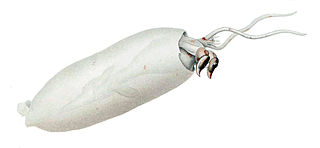
Sandalops melancholicus, the sandal-eyed squid or melancholy cranch squid, is a small species of glass squid. It is known to reach a mantle length of 11 cm (4.3 in). It is distributed in the tropical and subtropical oceans around the world. It is the only species in the genus Sandalops but some authorities suggest that this may be a species complex rather than a monotypic genus.
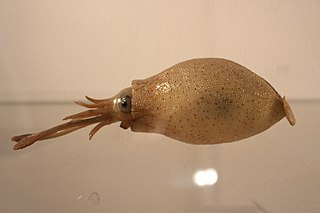
Cranchia scabra is a species of glass squid. It is the only species in the genus, and is fairly small. They reside in the epipelagic zones of the tropical Atlantic. The genus also contains bioluminescent species. Cranchia scabra are named after John Cranch who first described this species.
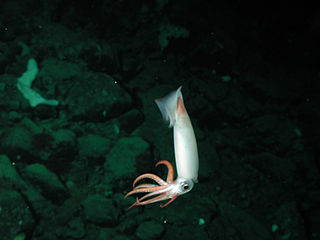
Gonatus onyx is in the class Cephalopoda and in the phylum Mollusca. It is also known as the clawed arm hook squid or the black-eyed squid. It got these names from the characteristic black eye and from its two arms with clawed hooks on the end that extend a bit further than the other arms. It is a squid in the family Gonatidae, found most commonly in the northern Pacific Ocean from Japan to California. They are one of the most abundant cephalopods off the coast of California, mostly found at deeper depths, rising during the day most likely to feed.

Thysanoteuthis rhombus, also known as the diamond squid,diamondback squid, or rhomboid squid, is a large species of squid from the family Thysanoteuthidae which is found worldwide, throughout tropical and subtropical waters. T. rhombus is given its name for the appearance of the fins that run the length of the mantle. They are a fast growing species with a lifespan of approximately 1 year. The diamond squid is the only cephalopod species known to be monogamous. T. rhombus often preys on fish and other small cephalopods at varying water depths. This species is commercially fished in Japan, specifically in the Sea of Japan and Okinawa.
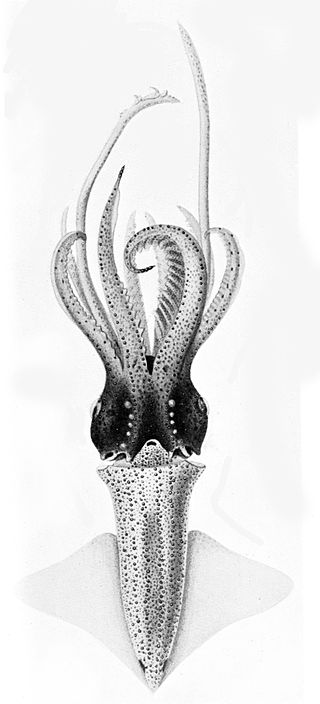
Abraliopsis morisii is a species of bioluminescent squid in the family Enoploteuthidae. The species occurs in tropical to warm temperate waters in the Atlantic Ocean, including the Gulf of Mexico and the Mediterranean Sea. It can be found in the epipelagic and mesopelagic zones. Jean Baptiste Vérany described the species in 1839 and it reaches lengths of 25 to 33 millimetres. It is rated as least concern by the International Union for Conservation of Nature (IUCN).

Bathyteuthis abyssicola, also known as the deepsea squid, is a species of squid in the family Bathyteuthidae.

Heteroteuthis dispar, also known as the odd bobtail, is a small deep water squid found in the North Atlantic Ocean and the Mediterranean Sea.

Galiteuthis glacialis is a species of glass squid from the Antarctic Convergence. It is in the family Cranchiidae and subfamily Taoniinae. They are endemic to the Antarctic and are found in the Southern Ocean, around the Weddell Sea and the South Shetland Islands. Galiteuthis glacialis are one of the most plentiful and widely dispersed species of Antarctic squid. These squids are found in the mesopelagic and bathypelagic layers of the open ocean and demonstrate vertical migration. They can reach a maximum mantle length of 500 mm (0.5m).
Sthenoteuthis pteropus, also known as the orangeback flying squid or orangeback squid, is a species of cephalopod in the family Ommastrephidae. It is native to tropical parts of the Atlantic Ocean where it is found to depths of about 200 m (656 ft).
Brachioteuthis riisei is a species of squid in the family Brachioteuthidae.
Taonius borealis is a glass squid belonging to the genus Taonius. It is found in the North Pacific Ocean, ranging from Japan to southern California.

Taonius belone is a glass squid belonging to the genus Taonius from the family Cranchiidae. It occurs in the northern subtropical and in the tropical or equatorial waters of the Pacific Ocean and the Indian Ocean.
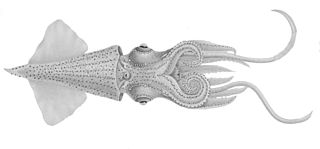
Enoploteuthis leptura, the hooked enope squid, is a species of squid from the family Enoploteuthidae. It is the type species of the genus Enoploteuthis, which is in turn the type genus of the Enoploteuthidae.
Gonatopsis okutanii is a species of squid from the family Gonatidae from the northern Pacific Ocean. It is of uncertain taxonomic status, the presence of remnant tentacles on spent females indicate that this species does not belong in the genus Gonatopsis and the differences between this species and Gonatus makodai have led to some authorities stating that G. okutanii is a junior synonym of Eogonatus tinro. However the World Register of Marine Species still recognises Gonatopsis okutanii as the valid name for this taxon.

Gonatopsis borealis, the Boreopacific armhook squid, is a species of squid from the North Pacific Ocean. It is a member of the family Gonatidae. It is an abundant species which is currently caught mainly as a bycatch by fishing boats targeting other quarry. It is an important prey species for many commercially important species of fish, as well as for marine mammals.
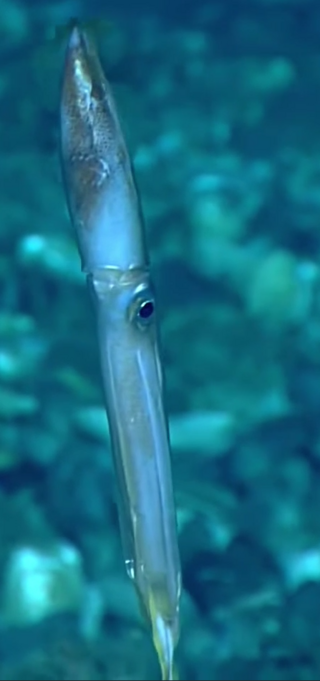
Neoteuthis is a monotypic genus of squid, the sole member is Neoteuthis thielei, from the family Neoteuthidae. This species has long tentacular clubs measuring 60% of the mantle length and fins which are 70% of its mantle length. It has a proximal locking-apparatus for the club which is restricted to manus, which in turn has proximal suckers which are circular. It has been recorded from the South Atlantic Ocean, North Atlantic Ocean, near the Canary Islands and North Pacific Ocean, north of Hawaii. The paralarvae and juveniles are found in the epipelagic to mesopelagic zones while adults occur in the mesopelagic to bathypelagic zones.
Eucleoteuthis is a monotypic genus of squid from the family Ommastrephidae; the only species is Eucleoteuthis luminosa, the striped flying squid or luminous flying squid.
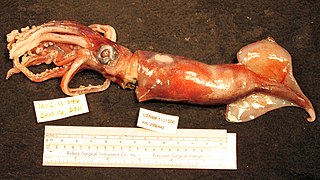
Ornithoteuthis antillarum, the Atlantic bird squid, is a species of flying squid from the family Ommastrephidae which is found in the warmer waters of the Atlantic Ocean. This species is an important component of the diet of many species of fish and of cetaceans. It is taken as a bycatch in fisheries but has the potential to be commercially important if appropriate fishing methods can be developed.
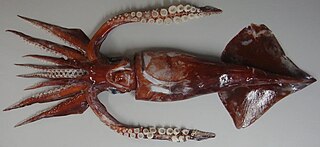
The Antarctic flying squid is a species of squid from the subfamily Todarodinae of the family Ommastrephidae, a family of pelagic squid from the order Oegopsida. It has a circumglobal distribution in the seas around the lower latitudes of the Southern Ocean.















